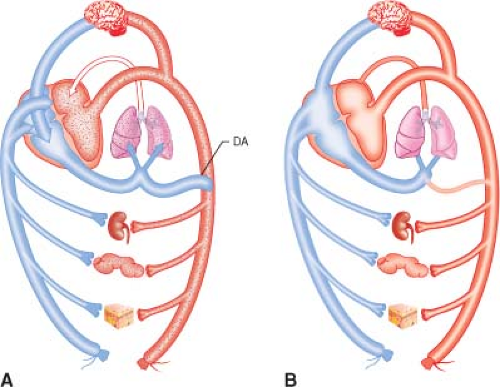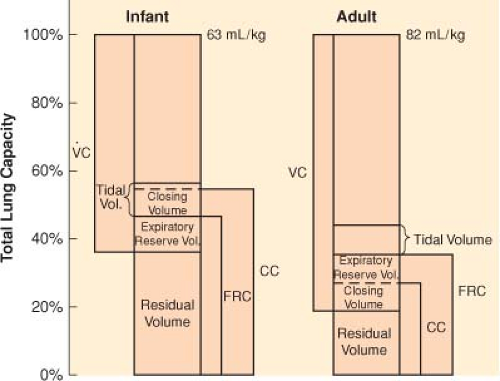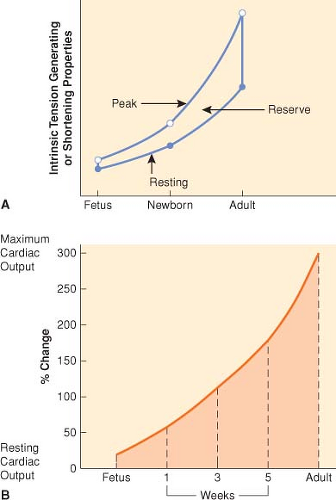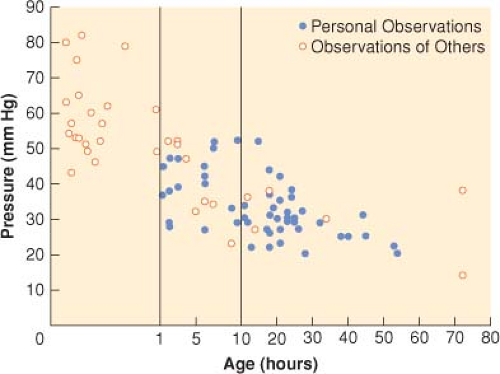Neonatal Anesthesia
The first year of life is characterized by an almost miraculous growth (body weight changes by a factor of three) in size and maturity (Hall SC, Suresh S. Neonatal anesthesia. In: Barash PG, Cullen BF, Stoelting RK, Cahalan MK, Ortega R, Stock MC, eds. Clinical Anesthesia. Philadelphia: Lippincott Williams & Wilkins; 2013:1178–1215).
I. Physiology of the Infant and the Transition Period
The newborn period has been defined as the first 24 hours of life and the neonatal period as the first month. The first 72 hours are especially significant for the cardiovascular, pulmonary, and renal systems.
The Cardiovascular System (Fetal Circulation) (Fig. 41-1A)
Changes at Birth (Fig. 41-1B)
Myocardial function is different in neonates because the cardiac myocytes have less organized contractile elements than in children and adults. The neonatal myocardium cannot generate as much force as in older children and is relatively noncompliant. Consequently, there is limited functional reserve in the neonatal period, and afterload increases are particularly poorly tolerated.
Especially in the first 3 months of life, the influence of the parasympathetic nervous system on the heart is more mature than the influence of the sympathetic system, and the myocardium does not respond to inotropic support as well as in older children and adults.
Even in the absence of stress, the neonatal heart has limited ability to increase cardiac output compared with the mature heart (Fig. 41-2).
The Pulmonary System
The airways and alveoli continue to grow after birth, with the alveoli increasing in number until about 8 years of age.
With the initiation of ventilation, the alveoli transition from a fluid-filled to an air-filled state, and a normal ventilatory pattern with normal volumes develops in the first 5 to 10 minutes of life. Blood gases stabilize with the
establishment of increased pulmonary blood flow (Table 41-1).

Figure 41-1. A. Schematic representation of the fetal circulation. B. Schematic representation of the circulation in the normal newborn. DA = ductus arteriosus.
Tidal volume is about the same in neonates as in children and adults on a volume per kilogram body weight measure, but the respiratory rate is increased in neonates (Table 41-2 and Fig. 41-3).
Increased minute ventilation mirrors the higher oxygen consumption in neonates (about double that seen in adults).
The ratio of minute ventilation to functional residual capacity (FRC) is two to three times higher in newborns. As a result, anesthetic induction and emergence with a volatile anesthetic agent should be faster. In addition, the decrease in FRC relative to minute ventilation and oxygen consumption means that there is less “oxygen reserve” in the FRC than in older children and adults. There is a more rapid decrease in arterial oxygen levels in newborns in the presence of apnea or hypoventilation.
Decreased surfactant production caused by prematurity or other conditions such as maternal diabetes can cause respiratory distress syndrome (RDS). Commercially available surfactant is extraordinarily useful in treating and preventing RDS in susceptible patients. In addition, surfactant can improve gas exchange in preterm infants who may not have RDS but are stressed by sepsis, heart failure, or other systemic problems.
Neonates do not respond as well to hypercapnia as older children.
Table 41-1 Normal Blood Gas Values in Neonates
Subject
Age
PO2 (mm Hg)
PCO2 (mm Hg)
pH
Fetus (term)
Before labor
25
40
7.37
Fetus (term)
End of labor
10–20
55
7.25
Newborn (term)
10 min
50
48
7.20
Newborn (term)
1 hr
70
35
7.35
Newborn (term)
1 wk
75
35
7.40
Newborn (preterm, 1,500 g)
1 wk
60
38
7.37
Persistent Pulmonary Hypertension of Newborns (Fig. 41-4)
Hypoxia and acidosis, along with inflammatory mediators, may cause pulmonary artery pressure to persist at a high level or after initially decreasing to increase to pathologic levels (persistent fetal circulation).
The elevated pulmonary vascular resistance causes both the ductus arteriosus and foramen ovale to remain open,
with subsequent right-to-left (bypassing the pulmonary circulation) shunting.
Treatment goals are to achieve a PaO2 of 50 to 70 mm Hg and a PaCO2 of 50 to 55 mm Hg.
Table 41-2 Comparison of Normal Respiratory Values in Infants and Adults
Parameter
Infant
Adult
Respiratory frequency
30–50
12–16
Tidal volume (mL/kg)
7
7
Dead space (mL/kg)
2.0–2.5
2.2
Alveolar ventilation (mL/kg/min)
100–150
60
Functional residual capacity (mL/kg)
27–30
30
Oxygen consumption
7–9
3

Figure 41-3. Static lung volumes of infants and adults. CC = closing capacity; FRC = functional residual capacity; VC = vital capacity.
Meconium Aspiration
Meconium aspiration may be a marker of chronic fetal hypoxia in the third trimester. This condition is different from the meconium aspiration that occurs during delivery, which is thick and mechanically obstructs the tracheobronchial system.
Current recommendations for intubation and suctioning for newborns at delivery with frank meconium aspiration or meconium staining (approximately 10% of newborns) emphasize a conservative approach. Routine oropharyngeal suctioning of meconium is recommended immediately at the time of delivery, but tracheal intubation and suctioning should be performed selectively.
If the newborn is vigorous and crying, no further suctioning is needed.
If meconium is present and the newborn is depressed, the trachea should be intubated and meconium and other aspirated material suctioned from beneath the glottis.
The Renal System
At birth, the glomerular filtration rate (GFR) is low but increases significantly in the first few days and doubles in the first 2 weeks; however, it does not reach adult levels until about 2 years of age. The limited ability of newborns’ kidneys to concentrate or dilute urine results from this low GFR and decreased tubular function.
The half-life of medications excreted by means of glomerular filtration is prolonged in newborns. The relative inability to conserve water means that neonates, especially in the first week of life, tolerate fluid restriction poorly. In addition, the inability to excrete large amounts of water means that newborns tolerate fluid overload poorly.
Fluid and Electrolyte Therapy in the Neonate
Full access? Get Clinical Tree










